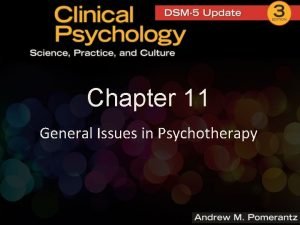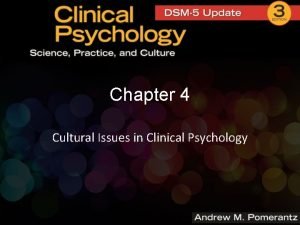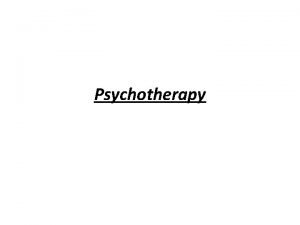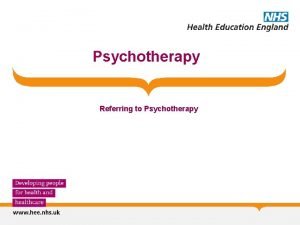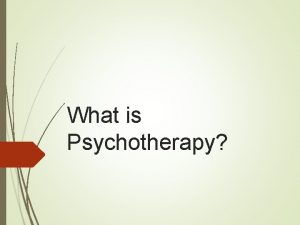Clinical Therapy and Issues I Psychotherapy treatment of






- Slides: 6

Clinical Therapy and Issues

I. Psychotherapy: treatment of psychological disorders by methods that include an ongoing relationship between a therapist and a client. A. Psychoanalysis 1) Free Association: the client thinks about a problem and then says everything that comes to mind related to it. 2) Transference: the client’s experience of feelings previously associated with a parent or other important figure are “transferred” to therapist. 3) Resistance: a continued repression that interferes with therapy.

B. Behavior Therapy: begins with specific behavioral goals and then helps the client learn how to achieve those goals. 1) Aversion Therapy: an attractive stimulus is paired with a noxious stimulus in order to elicit a negative reaction to the target stimulus. 2) Social-Learning Therapy: clients learn how to overcome certain behavioral problems by observing and imitating the behaviors of other people without those behavioral problems. C. Cognitive Therapy: seeks to improve people’s functioning by changing their thoughts and beliefs. 1) Rational-Emotive Therapy: assumes that thoughts precede emotions, and that unpleasant feelings are a result of irrational thoughts.

D. Cognitive-Behavior Therapy: a hybrid of cognitive and behavior therapy. E. Humanistic Therapy I: Person-Centered Therapy: therapist listens to the client with total acceptance & unconditional positive regard. F. Humanistic Therapy II: Gestalt Therapy: therapist has people act out unfulfilled fantasies or dreams in a safe environment to achieve satisfaction regarding those needs. G. Family Systems Therapy: an individual’s problems arise in a family setting and therefore must be dealt with by working to improve family relationships and communication. H. Group Therapy: involves the treatment of many clients all at once. I. Self-Help Groups: same as group therapy but without a therapist.

II. How effective is psychotherapy? III. Social and Legal Aspects of Treatment A. Deinstitutionalization: the trend over the second part of the twentieth century of removing patients from mental hospitals. B. Involuntary Commitment and Treatment C. The Duty to Protect 1) Tarasoff Case: established that a therapist who knows that a client has harmful intent towards an identified person or persons has a duty to break confidentiality with the client to protect the endangered person.

D. The Insanity Defense 1) The M’Naghten Rule: in order to be judged insane at the time of a crime, a person must be so disordered that they cannot understand what they are doing. IV. Preventing Mental Illness A. Community Psychologists: focus on the needs of groups rather than individuals and look at various ways to circumvent mental illness or lessen its damaging effects. 1) Prevention: methods aimed at stopping mental illness before it begins. 2) Intervention: identifying a disorder in its early stages and relieving it. 3) Maintenance: taking steps to prevent an illness from becoming more serious.
